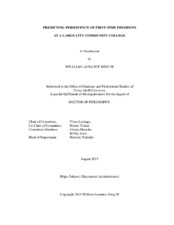| dc.description.abstract | The lack of student persistence is a burgeoning issue and over the last 40 years has become a national concern among researchers, administrators, policymakers and practitioners. Given the low persistence rates of first-year students at America’s community colleges, leaders are searching for useful and successful strategies that will aid in closing the gap in student attrition. Successful completion of a degree or certificate is often considered the great economic equalizer in today’s society from a public and cultural perspective.
The purpose of this research study was to empirically investigate the odds ratio associated with predicting persistence that exists between first-time freshmen students who lived in campus housing and those who live off-campus at a large-city community college referred to as LCCC. Specifically, the focus of this study was to determine whether living in on-campus housing, receiving needs-based federal financial aid (Pell Grant), ethnicity, gender and enrolling in one or more developmental education courses are predictors of persistence. This study was predicated on the collection of quantitative data from a large-city community college’s student information system from the years 2010 through 2013.
The researcher has concluded based on the data analysis of this research study the results were statistically insignificant for those students living on-campus when compared to those students living off-campus. An analysis of Ethnicity as a predictor of persistence revealed that in the short-term African-American students actually persisted at higher rates than their counterparts. However, in three of the last four semesters analyzed, African-Americans persisted at significantly lower rates than White students. Lastly, an analysis of the students who were enrolled in Developmental Education (Remedial) courses suggested that the odds are significantly lower concerning persistence versus their counterparts. However, it must be noted that both Hispanic students and those receiving needs-based financial aid (Pell) attrition was no worse than their counterparts.
Based on the complex nature of both the community college student and the unique opportunity for them to live on-campus, additional data is required in order to measure and evaluate whether housing status promotes improved academic persistence. The reported research studies pertaining to community colleges and living on-campus are meager at best. | en |


